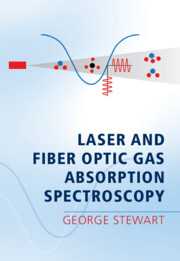Book contents
- Laser and Fiber Optic Gas Absorption Spectroscopy
- Laser and Fiber Optic Gas Absorption Spectroscopy
- Copyright page
- Dedication
- Contents
- Preface
- 1 Absorption Spectroscopy of Gases
- 2 DFB Lasers for Near-IR Spectroscopy
- 3 Wavelength Modulation Spectroscopy with DFB Lasers
- 4 Photoacoustic Spectroscopy with DFB Sources
- 5 Design and Application of DFB Laser Systems and Optical Fibre Networks for Near-IR Gas Spectroscopy
- 6 Principles of Fibre Amplifiers and Lasers for Near-IR Spectroscopy
- 7 Applications of Fibre Amplifiers and Lasers in Spectroscopy
- 8 Mid-IR Systems and the Future of Gas Absorption Spectroscopy
- Index
- References
1 - Absorption Spectroscopy of Gases
Published online by Cambridge University Press: 07 April 2021
- Laser and Fiber Optic Gas Absorption Spectroscopy
- Laser and Fiber Optic Gas Absorption Spectroscopy
- Copyright page
- Dedication
- Contents
- Preface
- 1 Absorption Spectroscopy of Gases
- 2 DFB Lasers for Near-IR Spectroscopy
- 3 Wavelength Modulation Spectroscopy with DFB Lasers
- 4 Photoacoustic Spectroscopy with DFB Sources
- 5 Design and Application of DFB Laser Systems and Optical Fibre Networks for Near-IR Gas Spectroscopy
- 6 Principles of Fibre Amplifiers and Lasers for Near-IR Spectroscopy
- 7 Applications of Fibre Amplifiers and Lasers in Spectroscopy
- 8 Mid-IR Systems and the Future of Gas Absorption Spectroscopy
- Index
- References
Summary
The fundamental description of the absorption of light by a gas through the Beer-Lambert law is introduced with the definitions given of the important parameters, such as line-strength, absorption cross-section and absorption coefficient. Broadening of gas absorption lines from Doppler effects and molecular collisions is explained in detail and the consequent absorption line-shape functions are presented in the form of Gaussian, Lorentzian or Voigt profiles. The extraction of information on the gas concentration, pressure or temperature from a measured line-shape is discussed, along with the practical issues and limitations. The origin and nature of the absorption lines arising from the excitation of rotational and vibrational states of gas molecules is reviewed with a particular interest in the overtone lines in the near-IR region. Examples of near-IR absorption lines from the HITRAN database for carbon monoxide, carbon dioxide, acetylene, methane, water, ammonia and hydrogen sulfide are presented so that the optical attenuation may be calculated in the design of a practical gas sensor system.
Keywords
- Type
- Chapter
- Information
- Laser and Fiber Optic Gas Absorption Spectroscopy , pp. 1 - 20Publisher: Cambridge University PressPrint publication year: 2021



